
Precalculus Enhanced with Graphing Utilities, Books a la Carte Edition Plus NEW MyLab Math -- Access Card Package (7th Edition)
7th Edition
ISBN: 9780134268231
Author: Michael Sullivan, Michael Sullivan III
Publisher: PEARSON
expand_more
expand_more
format_list_bulleted
Concept explainers
Textbook Question
Chapter B, Problem 28SB
In Problems 5-28, determine whether each sequence converges or diverges. If it converges, find its limit.
Expert Solution & Answer
Want to see the full answer?
Check out a sample textbook solution
Students have asked these similar questions
After a great deal of experimentation, two college senior physics majors determined that when a bottle of French champagne is shaken several times, held upright, and uncorked,
its cork travels according to the function below, where s is its height (in feet) above the ground t seconds after being released.
s(t)=-16t² + 30t+3
a. How high will it go?
b. How long is it in the air?
+6x²+135x+1) (0≤x≤10). a) Find the number of units
The total profit P(x) (in thousands of dollars) from a sale of x thousand units of a new product is given by P(x) = In (-x²+6x² + 135x+
that should be sold in order to maximize the total profit. b) What is the maximum profit?
The fox population in a certain region has an annual growth rate of 8 percent per year. It is estimated that the
population in the year 2000 was 22600.
(a) Find a function that models the population t years after 2000 (t = 0 for 2000).
Your answer is P(t)
=
(b) Use the function from part (a) to estimate the fox population in the year 2008.
Your answer is (the answer should be an integer)
Chapter B Solutions
Precalculus Enhanced with Graphing Utilities, Books a la Carte Edition Plus NEW MyLab Math -- Access Card Package (7th Edition)
Ch. B - If a sequence { S n } converges to L , we call L...Ch. B - If a 1 , a 2 ,..., a n ,... is some collection of...Ch. B - Prob. 3CVCh. B - Prob. 4CVCh. B - Prob. 5SBCh. B - Prob. 6SBCh. B - In Problems 5-28, determine whether each sequence...Ch. B - In Problems 5-28, determine whether each sequence...Ch. B - In Problems 5-28, determine whether each sequence...Ch. B - Prob. 10SB
Ch. B - Prob. 11SBCh. B - In Problems 5-28, determine whether each sequence...Ch. B - In Problems 5-28, determine whether each sequence...Ch. B - In Problems 5-28, determine whether each sequence...Ch. B - Prob. 15SBCh. B - Prob. 16SBCh. B - Prob. 17SBCh. B - In Problems 5-28, determine whether each sequence...Ch. B - Prob. 19SBCh. B - In Problems 5-28, determine whether each sequence...Ch. B - Prob. 21SBCh. B - Prob. 22SBCh. B - Prob. 23SBCh. B - Prob. 24SBCh. B - Prob. 25SBCh. B - Prob. 26SBCh. B - In Problems 5-28, determine whether each sequence...Ch. B - In Problems 5-28, determine whether each sequence...Ch. B - In Problems 29-32, find the first five terms in...Ch. B - In Problems 29-32, find the first five terms in...Ch. B - Prob. 31SBCh. B - In Problems 29-32, find the first five terms in...
Additional Math Textbook Solutions
Find more solutions based on key concepts
A categorical variable has three categories, with the following frequencies of occurrence: a. Compute the perce...
Basic Business Statistics, Student Value Edition
In Exercises 17-24, evaluate the double integral over the given region R.
17.
University Calculus: Early Transcendentals (4th Edition)
Houses A real estate agent claims that all things being equal, houses with swimming pools tend to sell for less...
Introductory Statistics
To find slopeof the line that passes through R(4,1) and S(−2,6) .
Pre-Algebra Student Edition
The equivalent expression of x(y+z) by using the commutative property.
Calculus for Business, Economics, Life Sciences, and Social Sciences (14th Edition)
Read about basic ideas of statistics in Common Core Standards for grades 3-5, and discuss why students at these...
A Problem Solving Approach To Mathematics For Elementary School Teachers (13th Edition)
Knowledge Booster
Learn more about
Need a deep-dive on the concept behind this application? Look no further. Learn more about this topic, calculus and related others by exploring similar questions and additional content below.Similar questions
- rarrow_forwardThe solutions are 1 where x1 x2- ● Question 11 Solve: x 54 Give your answer as an interval. Question 12arrow_forwardA population of deer in Pierce County currently has 1875 deer, but due to urban development, the population is decreasing at a rate of 1.1% a year. a) Assuming this growth rate continues, find the formula for a function f(t) describing this population. b) In how many years will the population reach 1300? Do the problems on your own paper, show all your work, and submit your scanned work below. Choose File No file chosenarrow_forward
- Question 3 Rewrite 4 = log₂(16) in exponential form. Question 4 症 If log, (6x+3)= 4, then rarrow_forwardQuestion 6 Find the solution of the exponential equation 2t 100(1.07) 2 = 500,000 in terms of logarithms, or correct to four decimal places. t=arrow_forwardQuestion 6 Find the solution of the exponential equation 100(1.07)² = 500, 000 in terms of logarithms, or correct to four decimal places. t = Question 7 Solve the equation.arrow_forward
arrow_back_ios
SEE MORE QUESTIONS
arrow_forward_ios
Recommended textbooks for you
- Algebra & Trigonometry with Analytic GeometryAlgebraISBN:9781133382119Author:SwokowskiPublisher:Cengage

Algebra & Trigonometry with Analytic Geometry
Algebra
ISBN:9781133382119
Author:Swokowski
Publisher:Cengage
Sequences and Series Introduction; Author: Mario's Math Tutoring;https://www.youtube.com/watch?v=m5Yn4BdpOV0;License: Standard YouTube License, CC-BY
Introduction to sequences; Author: Dr. Trefor Bazett;https://www.youtube.com/watch?v=VG9ft4_dK24;License: Standard YouTube License, CC-BY